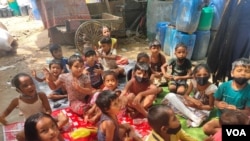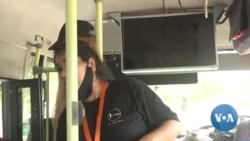Sitting in a bus that serves as a classroom, about 50 children from a poor New Delhi area learn how rain is formed as a teacher gives a science lesson.
A blackboard has been mounted in front, books are stacked on the side and the teacher goes down the narrow aisle to explain evaporation and condensation.
Started by nonprofit TejasAsia, this is one of four “Hope” buses that make their way into the city’s slums to teach children who do not attend regular school.
“I have learned multiplication tables, ABCs, and Hindi language vowel signs,” said 9-year-old Salima Khatun, sitting in the bus parked under the shade of a tree on a hot summer day.
The mobile schools are among several initiatives started by Indian nonprofits to educate children who do not attend school, even though education in government-run schools is free.
“If they cannot go to school, the school must come to them,” Ebna Edwin, project coordinator, told VOA.
Children of migrant laborers often drop out of school in the city because they do not have relevant identity cards. Some could not continue their schooling during the COVID-19 pandemic because they could not attend online classes -- only 1 in 4 children have access to the internet and digital devices in India, according to UNICEF.
Some youngsters do not attend school because they have to do housework and take care of siblings while their mothers work as housemaids to supplement meager household incomes.
So, the team running the mobile schools engages younger children in learning activities outside the bus. A simple meal of rice and lentils after classes provides more incentive to both children and parents -- persuading them to send children for the classes is not always easy.
“When we go to a community it is a big challenge to create awareness, to make parents understand the value of education, because they don’t really understand what this all about,” said TejasAsia founder Marlo Philip.
“Then there is the trust factor, what will we do with their children? So, it takes about six months for us to build relationships in every community with every family,” he said.
The two-hour classes held five days a week inside the bus serve as a bridge to regular school. As the age groups are mixed, the learning spans from language skills to math and basic science lessons.
“We spend six months to two years to prepare every child and make them equal to the standards of other children of the school, so that when they get to proper schools, they are ready to continue,” according to Philip.
Launched seven years ago, the initiative has expanded to reach eight locations in the city.
The mobile schools accustom children who have never attended school to a classroom environment and discipline, and show them that education can open different opportunities.
Edwin said that after a few months she notices a visible change in the children.
“They can dream big, they can have a better future, they also feel that their present life is not the ultimate end,” she said.
Those dreams vary. Twelve-year-old Ricki Pal now hopes to work in the city’s gleaming glass-and-chrome buildings across the road that separates his poor neighborhood from richer areas. “When I grow up, I want to do a proper job,” he said.
Nine-year-old Salima wants to be a teacher, while Mosami Khatun’s favorite class is art. She spends her spare time sketching and told VOA she wants to be an artist.











